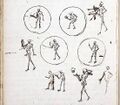Phantasmagoria (nonfiction): Difference between revisions
No edit summary |
No edit summary |
||
| (One intermediate revision by the same user not shown) | |||
| Line 30: | Line 30: | ||
* [[Optical toys (nonfiction)]] | * [[Optical toys (nonfiction)]] | ||
* [[Phenakistiscope (nonfiction)]] - a spinning cardboard disc attached vertically to a handle which creates a fluid illusion of motion. | * [[Phenakistiscope (nonfiction)]] - a spinning cardboard disc attached vertically to a handle which creates a fluid illusion of motion. | ||
* [[Praxinoscope (nonfiction)]] | * [[Praxinoscope (nonfiction)]] - an animation device, the successor to the zoetrope. It was invented in France in 1877 by Charles-Émile Reynaud. Like the zoetrope, it used a strip of pictures placed around the inner surface of a spinning cylinder. The praxinoscope improved on the zoetrope by replacing its narrow viewing slits with an inner circle of mirrors, placed so that the reflections of the pictures appeared more or less stationary in position as the wheel turned. | ||
* [[Precursors of film (nonfiction)]] | * [[Precursors of film (nonfiction)]] | ||
* [[Jacob Philadelphia (nonfiction)]] | * [[Jacob Philadelphia (nonfiction)]] | ||
| Line 36: | Line 36: | ||
* [[Thaumatrope (nonfiction)]] - an optical toy that was popular in the 19th century. A disk with a picture on each side is attached to two pieces of string. When the strings are twirled quickly between the fingers the two pictures appear to blend into one due to the persistence of vision. | * [[Thaumatrope (nonfiction)]] - an optical toy that was popular in the 19th century. A disk with a picture on each side is attached to two pieces of string. When the strings are twirled quickly between the fingers the two pictures appear to blend into one due to the persistence of vision. | ||
* [[Théâtre Optique (nonfiction)]] - an animated moving picture system invented by Émile Reynaud and patented in 1888. | * [[Théâtre Optique (nonfiction)]] - an animated moving picture system invented by Émile Reynaud and patented in 1888. | ||
* [[Zoetrope (nonfiction)]] | * [[Zoetrope (nonfiction)]] - one of several pre-film animation devices that produce the illusion of motion by displaying a sequence of drawings or photographs showing progressive phases of that motion. | ||
* [[Zoopraxiscope (nonfiction)]] | * [[Zoopraxiscope (nonfiction)]] - an early device for displaying moving images and is considered an important predecessor of the movie projector. | ||
External links | == External links == | ||
* [https://en.wikipedia.org/wiki/Phantasmagoria Phantasmagoria] @ Wikipedia | * [https://en.wikipedia.org/wiki/Phantasmagoria Phantasmagoria] @ Wikipedia | ||
Latest revision as of 07:04, 4 May 2020
Phantasmagoria (fantasmagorie, fantasmagoria) was a form of horror theater that (among other techniques) used one or more magic lanterns to project frightening images such as skeletons, demons, and ghosts onto walls, smoke, or semi-transparent screens, typically using rear projection to keep the lantern out of sight.
Mobile or portable projectors were used, allowing the projected image to move and change size on the screen, and multiple projecting devices allowed for quick switching of different images. In many shows the use of spooky decoration, total darkness, sound effects, (auto-)suggestive verbal presentation and sound effects were also key elements.
Some shows added all kinds of sensory stimulation, including smells and electric shocks. Even required fasting, fatigue (late shows) and drugs have been mentioned as methods of making sure spectators would be more convinced of what they saw.
The shows started under the guise of actual séances in Germany in the late 18th century, and gained popularity through most of Europe (especially England) throughout the 19th century.
In the News
Fiction cross-reference
Nonfiction cross-reference
- Electrotachyscope (nonfiction)
- Flip book (nonfiction)
- History of animation (nonfiction)
- History of film (nonfiction)
- Philip James de Loutherbourg (nonfiction) - Inventor of the Eidophusikona, a mechanical theater
- Light (nonfiction)
- Eadweard Muybridge (nonfiction)
- Optical toys (nonfiction)
- Phenakistiscope (nonfiction) - a spinning cardboard disc attached vertically to a handle which creates a fluid illusion of motion.
- Praxinoscope (nonfiction) - an animation device, the successor to the zoetrope. It was invented in France in 1877 by Charles-Émile Reynaud. Like the zoetrope, it used a strip of pictures placed around the inner surface of a spinning cylinder. The praxinoscope improved on the zoetrope by replacing its narrow viewing slits with an inner circle of mirrors, placed so that the reflections of the pictures appeared more or less stationary in position as the wheel turned.
- Precursors of film (nonfiction)
- Jacob Philadelphia (nonfiction)
- Strobe light (nonfiction)
- Thaumatrope (nonfiction) - an optical toy that was popular in the 19th century. A disk with a picture on each side is attached to two pieces of string. When the strings are twirled quickly between the fingers the two pictures appear to blend into one due to the persistence of vision.
- Théâtre Optique (nonfiction) - an animated moving picture system invented by Émile Reynaud and patented in 1888.
- Zoetrope (nonfiction) - one of several pre-film animation devices that produce the illusion of motion by displaying a sequence of drawings or photographs showing progressive phases of that motion.
- Zoopraxiscope (nonfiction) - an early device for displaying moving images and is considered an important predecessor of the movie projector.
External links
- Phantasmagoria @ Wikipedia

